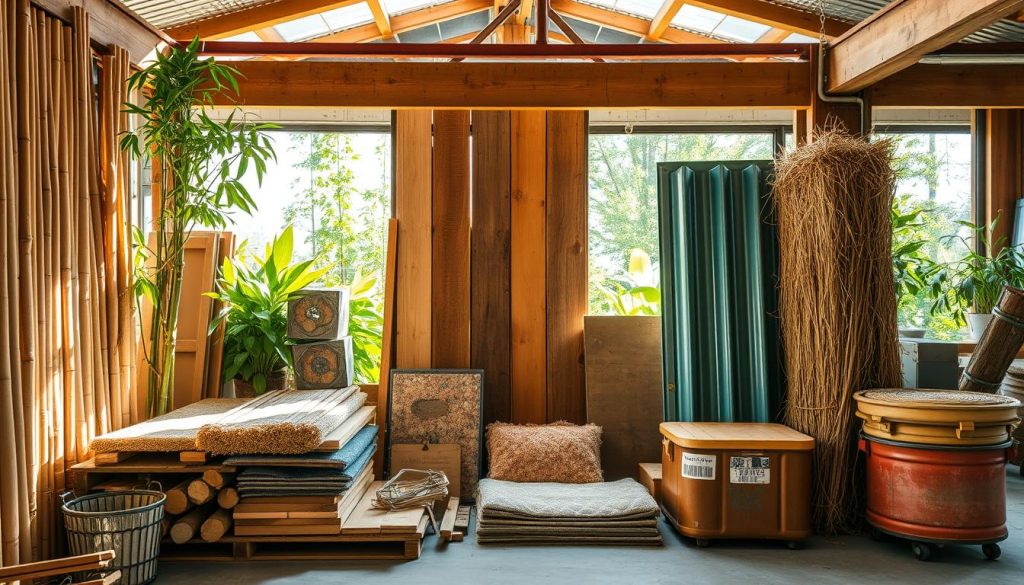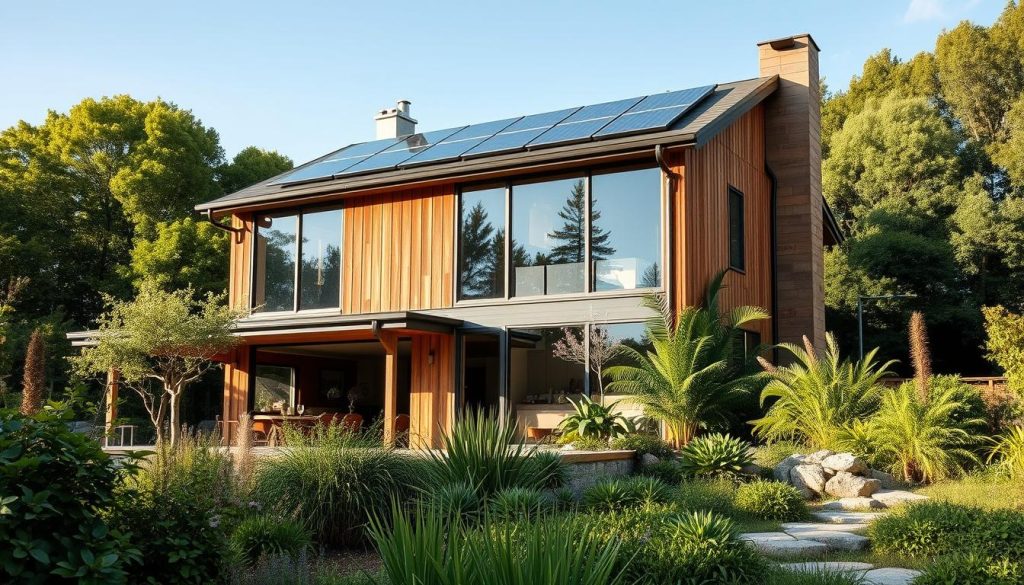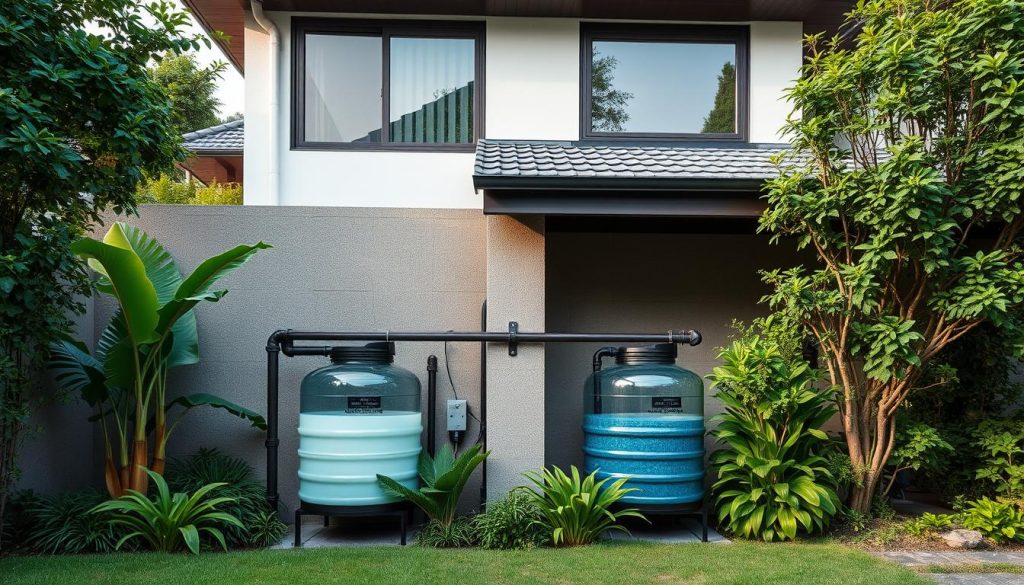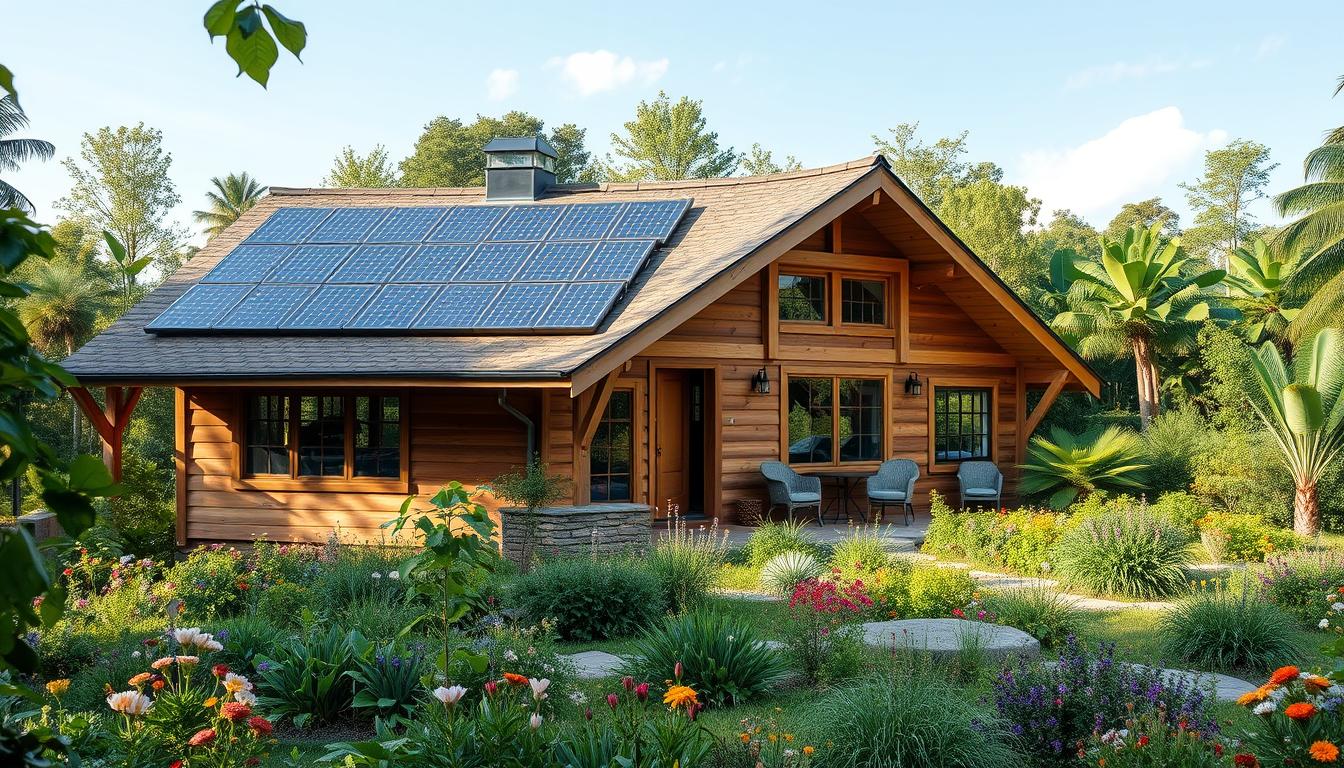As a homeowner, I’m dedicated to making my space both comfy and good for the planet. I’m thrilled to share this guide on green building and home renovation. We’ll look at the basics of eco-friendly construction, pick the best materials, and talk about saving energy and water.
We’ll also explore how to make your yard more sustainable and the benefits of smart home tech. By the end, you’ll know how to turn your home into a greener, more eco-friendly space.
Understanding Sustainable Building Principles
Sustainable building principles help create homes that use less energy and harm the environment less. These principles focus on using fewer resources, making less waste, and keeping occupants healthy. Let’s dive into what makes a building sustainable and its benefits.
What Makes a Building Sustainable?
A sustainable building uses design and construction methods that focus on a few key areas:
- Energy efficiency comes from insulation, high-performance windows, and solar panels.
- Water is saved with low-flow fixtures and rainwater systems.
- Eco-friendly, local materials are used to cut down on carbon emissions.
- Good indoor air quality is ensured with ventilation and non-toxic materials.
- Construction waste is reduced during and after building.
Benefits of Sustainable Construction
Choosing sustainable design for your home offers many benefits:
- It saves money on energy and is better for the environment.
- It improves health and comfort by ensuring good air quality.
- It increases your home’s value and appeal.
- It helps your community and the planet by using resources wisely.
By applying sustainable building principles, you can make your home more energy-efficient and eco-friendly. This not only benefits you but also helps your community and the planet.
Choosing Sustainable Materials for Your Home

Building or renovating your home involves choosing the right materials. Eco-friendly architecture focuses on using materials that are good for the planet. These materials help make your home last longer and use less energy.
Eco-friendly Options
There are many sustainable materials to choose from. Recycled and reclaimed materials like glass, metal, and wood are popular. They help reduce waste and give old materials a new life.
Materials like bamboo, cork, and straw bale are also great choices. They are better for the environment than traditional building materials.
Local Sourcing Benefits
Try to use materials from local sources. This cuts down on carbon emissions from transportation. It also helps the local economy and supports community projects.
Choosing eco-friendly and local materials makes your home better for the planet. It shows your commitment to sustainability. This is key to reducing your home’s environmental impact.
Energy Efficiency in Renovation Projects

Home renovations should focus on energy efficiency. This makes your home use less energy, saving money and helping the environment. Key steps include energy audits and improving insulation and windows.
Importance of Energy Audits
Start with an energy audit before renovating. It checks how much energy your home uses and where to save. A pro will find leaks, check insulation, and look at your systems.
This info helps you choose the best renovations for energy savings and comfort.
Upgrading Insulation and Windows
Improving insulation and windows boosts your home’s energy use. Good insulation keeps your home’s temperature steady, saving energy and money. New windows also help keep your home warm in winter and cool in summer.
By focusing on energy efficiency, you save money and help the planet. An energy audit and upgrades like better insulation and windows make your home efficient and sustainable.
Water Conservation Techniques

We’re working hard to make our homes more sustainable, and saving water is key. There are smart ways to cut down on water use and lessen our impact on the planet. Let’s look at two great options: rainwater harvesting and using low-flow fixtures.
Rainwater Harvesting Systems
Rainwater harvesting is a clever way to save water. It lets us collect rainwater from our roofs for things like watering plants, flushing toilets, and washing clothes. These systems have a roof catchment, a tank, and a way to distribute the water.
They help us use less city water, recharge groundwater, and prevent flooding. It’s a win-win for our planet and our homes.
Low-Flow Fixtures and Fittings
Using low-flow fixtures is another smart move. These include showerheads, faucets, and toilets that use less water than old ones. Swapping out old plumbing for new, efficient ones can cut down our water use a lot.
These fixtures save water and lower our bills. They’re a smart choice for making our homes more sustainable.
By using these water-saving methods, we’re making our homes greener. Rainwater harvesting and low-flow fixtures help us save water and reduce our environmental impact. They’re key to building homes that are good for the planet.
Sustainable Landscaping Practices
As an eco-conscious homeowner, I’ve found great benefits in using Biophilic Design and Eco-Friendly Architecture in my landscaping. I’ve cut down on water use and made a beautiful, easy-to-care-for outdoor space. This space also helps local wildlife thrive.
Native Plant Selection
I focus on using native plants in my landscaping. I picked plants that are native to my area. They look great and help local animals by providing food and shelter.
These plants also need less water and care than non-native ones. They fit perfectly with the local climate and soil.
Xeriscaping for Minimal Water Use
I also use xeriscaping to save water. This method uses plants that don’t need much water and smart design. It makes my outdoor space beautiful with little water.
Xeriscaping is good for the planet and saves me money on water bills. It’s a win-win for me and the environment.
By choosing native plants and using xeriscaping, my outdoor space is now a lush, green, and eco-friendly haven. I’m happy to have a landscape that’s beautiful and eco-friendly. It shows my commitment to Biophilic Design and Eco-Friendly Architecture.
Smart Technologies for Sustainable Homes
We’re working hard to make homes more Energy-Efficient and Net-Zero. Smart technologies are key in this effort. They make our homes more sustainable and help us save energy and reduce our environmental impact.
Incorporating Smart Thermostats
Smart thermostats have changed how we control our home’s temperature. They learn our habits and adjust the temperature to save energy. With our smartphones and voice assistants, we can easily control our home’s climate.
Benefits of Solar Panels
More people are using solar panels to power their homes. Solar panels use the sun’s energy and can make our homes Net-Zero. This cuts down on carbon emissions and saves money on bills.
- Harness renewable solar energy to power your home
- Reduce your carbon footprint and environmental impact
- Potentially achieve net-zero energy consumption
- Take advantage of tax incentives and financial savings
Smart technologies help us build sustainable homes. They make our homes greener and more energy-efficient. As we keep innovating, we can make our homes better for the planet.
Certification Programs for Sustainable Building
Sustainable building certification programs guide us in building eco-friendly homes. LEED (Leadership in Energy and Environmental Design) and Energy Star ratings are key. They help us follow LEED Certification and Sustainable Design Principles.
LEED Certification Overview
LEED is a green building certification from the U.S. Green Building Council. It checks a building’s performance in areas like energy use and water saving. Getting LEED certified shows we care about the environment and can even increase our home’s value.
Energy Star Ratings
The Energy Star program is run by the U.S. Environmental Protection Agency. It highlights energy-efficient homes and products. An Energy Star rating means a home uses less energy, saving money and the planet.
Going for LEED Certification and Energy Star ratings means our homes are built sustainably. These programs help us create healthier, energy-saving homes. They lead us to a greener future.
Planning and Budgeting for Sustainable Renovations
Starting my sustainable building and renovation project requires careful planning and budgeting. The costs can seem overwhelming at first. But, with a smart plan, I can save money and help the environment in the long run.
Cost Considerations
Sustainable renovations might cost more at the start than traditional ones. Yet, they can save a lot on energy, water, and upkeep over time. I’ll look at the costs of energy-saving upgrades, solar panels, water-saving features, and eco-friendly materials.
By comparing the initial costs to the long-term savings, I can set a budget that fits my green goals.
Funding and Incentives Available
There are many ways to fund sustainable building and renovation projects. I’ll check out government programs for tax breaks, rebates, or low-interest loans. These are for energy-saving upgrades, solar panels, and water-saving features.
I’ll also look into green banks and eco-friendly lenders. Using these resources, I can lower the upfront costs. This makes my sustainable renovation more affordable and achievable.

